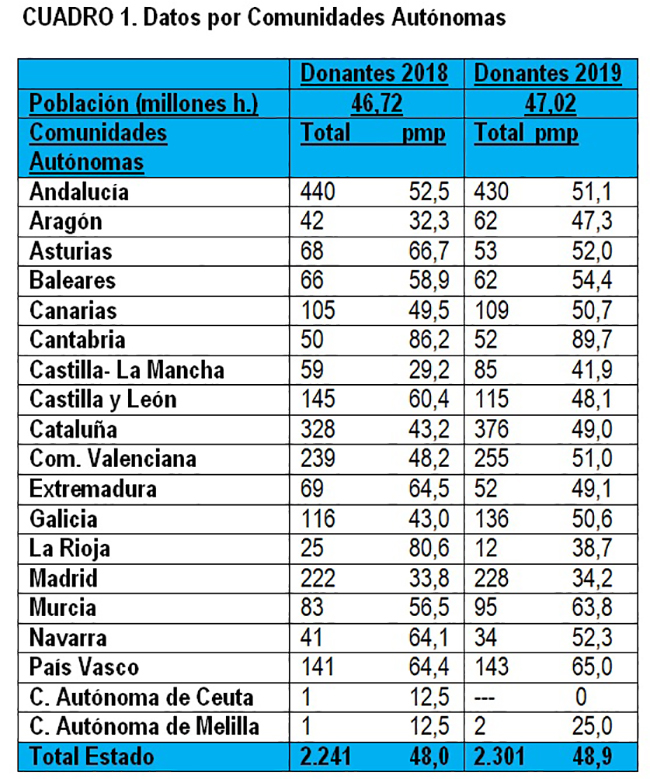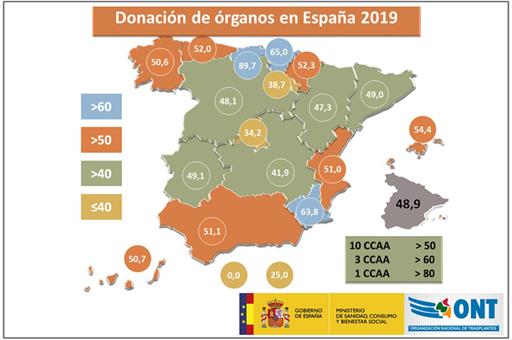Spanish National Transplant Organisation presents results from activity in 2019
Spain posts new all-time record with 48.9 donors per million population and approaches 5,500 transplants
News - 2020.1.10
This figure raises the transplant rate to 116 p.m.p. This fantastic result was made possible by the solidarity of Spanish society, the generosity of which is clearly shown year after year, and the enormous effort made by the Spanish coordination and transplant network.
'50x22' Plan
The Director of the Spanish National Transplant Organisation (Spanish acronym: ONT), Beatriz Domínguez-Gil, believes that these figures demonstrate the effectiveness of the measures contained in the '50x22' Strategic Plan that was launched by the ONT and the Regional Transplant Coordination Authorities in late 2017 to reach 50 donors p.m.p. and 5,500 transplants by 2022.
According to the data, the Spanish transplant system was on the verge of achieving the targets set in this plan two years ahead of schedule, a plan that was designed to make quantitative and qualitative improvements to transplant activity in our country.
These achievements were also made through support from the partnerships created by the ONT with the scientific societies of the various professionals, doctors and nurses who take part in the organ donation and transplantation process.
Among other things, the '50x22' Plan includes measures aimed at facilitating collaboration between intensive care units and other hospital services, especially emergency services, with hospital transplant coordinators; encouraging asystolic donation and its transformation into a multi-organ donation process; increasing living kidney donation and paediatric donation, combined with fostering the donation of organs in the private sector under supervision from the public sector so that every member of the public that wishes to donate organs is able to do so, irrespective of the healthcare system they choose.
New all-time highs
Despite already starting from a high level of excellence that is hard to surpass and an adverse situation for organ donation due to the advanced age of potential donors in Spain, efforts to innovate have already begun to produce results: new all-time organ donation and transplantation records in both the total number of donors (2,301) and the number of solid organ transplants (5,449). New all-time highs were also set in terms of kidney and lung transplantation.
In total, 3,423 kidney transplants, 1,227 liver transplants, 300 heart transplants, 419 lung transplants, 76 pancreas transplants and four intestine transplants were performed. The number of live-donor kidney transplants also rose by 14% to reach a total of 335 (compared with 293 in 2018). This type of transplant accounts for almost 10% of all kidney transplants.
In spite of reaching such a high number of organ transplants, a significant number of patients are still on lists waiting for organs to become available. At 31 December 2019, this number stood at 4,889 patients, of which 93 are children.
Donor profile
Asystolic donation is consolidating its position as the clearest way to increase the number of transplants, with a total of 744 donors representing an increase of 18% on the previous year. At present, the organs of 32% of donors are removed after circulatory death; i.e. one in three. More than 120 hospitals throughout the country (in 16 autonomous regions) are already accredited to perform this type of organ donation.
Donors dying in road traffic accidents account for 4.4% of the total, one of the lowest percentages in the last decade.
In terms of donor age, more than half (56.4%) are over 60; 32% are over 70; and 8.5% are over 80. The oldest age for an effective donor stands at 91, which enabled a liver transplant to be performed.
Objections from relatives now stand at 14%. This percentage falls to 9.5% in the case of donors after circulatory death.
Data by autonomous region
10 autonomous regions posted a figure of more than 50 donors p.m.p. Of those, one was close to 90 donors p.m.p. and two were above 60 donors p.m.p.
Cantabria again leads the table with a rate of 89.7 donors p.m.p. This is followed by the Basque Country (65), Murcia (63.8) and the Balearic Islands (54.4).
The increase in the number of donors in absolute terms is led by Catalonia, followed by Aragon, Galicia, Castile-La Mancha and the Region of Valencia. In percentage terms, the autonomous regions posting the highest growth in the number of donors are Aragon (up 47.6%), Castile-La Mancha (up 44.1%), Galicia (up 17.2%), Catalonia (up 14.6%) and Murcia (up 14.5%) (See table attached).
Furthermore, the ONT states that 1,200 patients received a transplant thanks to the exchange of organs between the regions of Spain, representing 24% of the total. In turn, 8% of transplant recipients receive an organ outside of the autonomous region where they reside. These two figures highlight the overlapping role played by the Spanish Transplant System.
Activity by hospital
By hospital, the units posting the greatest activity in 2019 were as follows:
- Highest number of donors (H. Univ. Virgen de la Arrixaca)
- Highest number of brain-dead donors (H. Univ. Virgen de la Arrixaca)
- Highest number of donors after circulatory death (H. Clinic de Barcelona)
- Highest number of kidney transplants (H. Univ. De Bellvitge)
- Highest number of living kidney transplants (H. Clinic de Barcelona)
- Highest number of liver transplants (H. Univ. La Fe)
- Highest number of heart transplants (H. Univ. La Fe)
- Highest number of lung transplants (H. Vall d´Hebron)
- Highest number of pancreas transplants (H. Clinic de Barcelona)
- Highest number of transplants in children (H. Univ. La Fe)
- Highest total number of transplants (H. Univ. La Fe)
Within hospital organ donation activity, it is worth noting:
- Hospital de Donostia de San Sebastián - one of the hospitals with no transplant activity - is the unit with the highest level of organ donation (a total of 56 donors).
Other outstanding achievements in 2019
- In conjunction with Italy, Spain performed the second international crossed kidney transplant in southern Europe, in a complicated logistics operation coordinated by the ONT involving the Puigvert Foundation in Barcelona and the 'Kidney Transplant' in Padua.
- After launching the incompatible AB0 child heart transplant programme in 2018, six such transplants have been performed in Spain (two at H. Univ. Gregorio Marañón and four at H. Univ. La Paz).
- Our country consolidated the programme of transplants from Virus C positive donors to Virus C negative patients. At the end of 2019, 101 transplants from VHC donors to recipients not infected by this virus had been performed.
- In November, the ONT set a new activity record by managing 19 donors in less than 24 hours. 27 hospitals in 13 autonomous regions of Spain and one French hospital took part in the various operations.
- A total of 127 highly sensitised - and therefore with little chance of finding a compatible donor - kidney patients were able to receive a transplant in 2019 thanks to the PATHI Programme (Spanish Prioritisation System for Highly Sensitised Patients). These patients had been on waiting lists for an average of six years because of their complicated immunology situation. In five years, 485 kidney patients have benefited from this programme.
- The ONT signed a partnership agreement with the Spanish Private Health Association (Spanish acronym: ASPE) to foster and standardise organ donation at private hospitals throughout the country in cooperation and under supervision from the public sector. In 2019, 40 donors (1.7% of the total) were identified in private hospitals: 13 in Madrid, 8 in Galicia, 7 in Catalonia, 4 in Andalusia, 4 in the Region of Valencia, 2 in the Balearic Islands, 1 in the Canary Islands and 1 in Navarre.
National Bone Marrow Plan
At 1 January 2020, Spain has a total of 420,730 bone marrow donors registered with the Spanish Register of Bone Marrow Donors (Spanish acronym: REDMO). Of those, 36,108 are donors who registered in 2019. This is an increase of 9.2% on the previous year. Increasing the number of donors registered with REDMO and achieving a qualitative improvement in the register are targets for stage three of the National Bone Marrow Plan.
 Ministerio de Sanidad, Consumo y Bienestar Social
Ministerio de Sanidad, Consumo y Bienestar Social
Non official translation





